Submitted:
28 February 2024
Posted:
14 March 2024
You are already at the latest version
Abstract
Keywords:
1. Introduction
2. Literature Review
2.1. Wellness Tourism
2.2. Service Innovation
2.3. Mixed Research Method
2.4. Sustainable Development
3. Materials and Methods
3.1. The Research Site
3.2. Data
3.3. Methods
3.3.1. Construct a Judgment Matrix

3.3.2. Solve the Judgment Matrix





3.3.3. Consistency Test
3.3.4. Determine the Weight
3.3.5. Four-Quadrant Coordinate Method
3.3.6. QSPM Analysis Method
3.4. Model Construction
| Indicator N. | Average Score | Main Indicator | Indicator N. | Average Score | Main Indicator |
|---|---|---|---|---|---|
| S1 S2 S3 S4 S5 S6 S7 S8 |
3.94 | Yes | W1 | 3.79 | Yes |
| 3.81 | Yes | W2 | 2.69 | No | |
| 3.68 4.0.4 2.04 2.93 2.15 2.86 |
Yes Yes No No No No |
W3 W4 W5 W6 W7 W8 |
3.59 3.87 3.49 2.47 2.80 2.32 |
Yes Yes Yes No No No |
|
| O1 O2 O3 O4 O5 |
3.81 | Yes | T1 | 4.20 | Yes |
| 3.68 3.55 2.58 3.94 |
Yes Yes No Yes |
T2 T3 T4 T5 |
2.49 4.03 3.87 2.64 |
No Yes Yes No |
4. Results
4.1. SWOT Factor Analysis
4.1.1. Strength
| Scenic Spot Name | Quality Level | Scenic Spot Type | Opening Time |
|---|---|---|---|
| Chongqing LocalJoy Resort Theme Park | AAAA | Animal/theme amusement park | Every day 9:00-17:30 |
| Chongqing Tea Mountain and Bamboo Forest | AAAA | Forest/Grassland | Every day 9:00-17:30 |
| Chongqing Stalagmite Mountain Scenic Area Chongqing Yongchuan Taohuayuan Tourist Resort Chongqing Yongchuan Songgai Ancient Town Chongqing Yongchuan Museum |
AAAA AAA AAA AAA |
Natural scenery Leisure vacation Characteristic neighborhood Cultural Museum |
Every day 9:00-17:30 Every day 9:00-17:30 Every day 9:00-17:30 9:00-17:30 (Closed every Monday) |
4.1.2. Weakness
4.1.3. Opportunity
4.1.4. Threaten
4.2. Hierarchical Model Analysis
4.2.1. Construction of Evaluation Index System
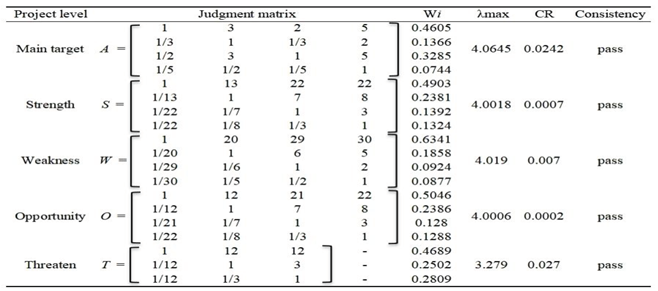
4.2.2. Development Strategy Analysis by QSPM
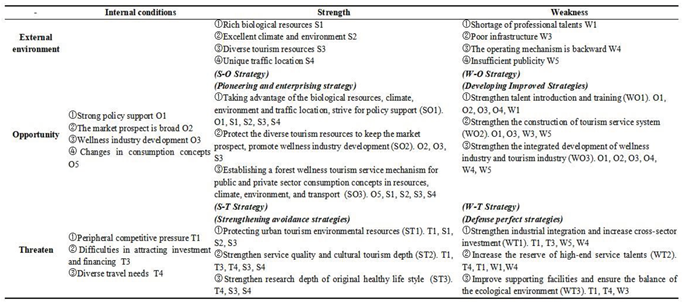
5. Discussion
5.1. Sustainable Development Strategies
5.1.1. Stimulate Market Demand
5.1.2. Policy Guidance
5.1.3. Improve the Service System and Enrich Tourism Products
5.2. Theoretical Contribution
5.3. Managerial Implications
6. Conclusions
Author Contributions
Funding
Institutional Review Board Statement
Informed Consent Statement
Data Availability Statement
Acknowledgments
Conflicts of Interest
References
- Li, W.; D., M.; Yuanhao, Q.; Z., Y. WELLNESS TOURISM SERVICES INNOVATION: A BIBLIOMETRIC REVIEW AND FUTURE RESEARCH AGENDA. CACTUS 2024, 5. [CrossRef]
- Global Wellness Institute. Global Wellness Economy Monitor 2023. Available online: https://globalwellnessinstitute.org/the-2023-global-wellness-economy-monitor/. (accessed on November 2023).
- Global Wellness Institute. The Global Wellness Economy: Looking Beyond COVID. Available online: https://globalwellnessinstitute.org/industry-research/the-global- wellness-economy-/. (accessed on December 2021).
- Pencarelli, T. The digital revolution in the travel and tourism industry. Inf. Technol. Tour. 2019, 22, 455–476. [Google Scholar] [CrossRef]
- Lu, J.; Xiao, X.; Xu, Z.; Wang, C.; Zhang, M.; Zhou, Y. The potential of virtual tourism in the recovery of tourism industry during the COVID-19 pandemic. Curr. Issues Tour. 2021, 25, 441–457. [Google Scholar] [CrossRef]
- Dunets, A.N.; Vakhrushev, I.B.; Sukhova, M.G.; Sokolov, M.S.; Utkina, K.M.; Shichiyakh, R.A. Selection of strategic priorities for sustainable development of tourism in a mountain region: concentration of tourist infrastructure or nature-oriented tourism. Entrep. Sustain. Issues 2019, 7, 1217–1229. [Google Scholar] [CrossRef] [PubMed]
- He, M.; Liu, B.; Li, Y. Recovery experience of wellness tourism and place attachment: insights from feelings-as-information theory. Int. J. Contemp. Hosp. Manag. 2022, 34, 2934–2952. [Google Scholar] [CrossRef]
- Poblete, L.; Eriksson, E.; Hellström, A.; Glennon, R. User involvement and value co-creation in well-being ecosystems. J. Heal. Organ. Manag. 2023, 37, 34–55. [Google Scholar] [CrossRef] [PubMed]
- Streimikiene, D.; Svagzdiene, B.; Jasinskas, E.; Simanavicius, A. Sustainable tourism development and competitiveness: The systematic literature review. Sustain. Dev. 2020, 29, 259–271. [Google Scholar] [CrossRef]
- Li, W.; Myagmarsuren, D.; Yuanhao, Q.; Yadmaa, Z.; Shanshan, L. Customer Engagement in Service Innovation Performance of the Wellness Industry - Based on the fsQCA Method. Phys. Med. Rehabilitation - Int. 2023, 10. [Google Scholar] [CrossRef]
- Li, W.; Myagmarsuren, D.; Yadmaa, Z. Digital Technology, Superior Support, and Employee Participation in Service Innovation Performance of Wellness Industry - Based on fsQCA Method. Journal of Management and Innovation, 2023, 1, 1–8. [Google Scholar]
- Han, J.; Zuo, Y.; Law, R.; Chen, S.; Zhang, M. Service Quality in Tourism Public Health: Trust, Satisfaction, and Loyalty. Front. Psychol. 2021, 12. [Google Scholar] [CrossRef]
- Han, S.; Ramkissoon, H.; You, E.; Kim, M.J. Support of residents for sustainable tourism development in nature-based destinations: Applying theories of social exchange and bottom-up spillover. J. Outdoor Recreat. Tour. 2023, 43. [Google Scholar] [CrossRef]
- Wang, L.; Togtokhbuyan, L.; Yadmaa, Z. Visual analysis of the international wellness tourism WOS literature from 1992 to 2019. Int. J. Spa Wellness 2021, 4, 1–16. [Google Scholar] [CrossRef]
- Venkatesh, V.; Morris, M. G.; Davis, G. B.; Davis, F. D. User acceptance of information technology: Toward a unified view. MIS quarterly, 2003, 27, 425–478. [Google Scholar] [CrossRef]
- Venkatesh, V.; Thong, J. Y.; Xu, X. Consumer acceptance and use of information technology: extending the unified theory of acceptance and use of technology. MIS quarterly, 2012, 27, 157–178. [Google Scholar] [CrossRef]
- Li, W.; Myagmarsuren, D.; Hao, Q.Y.; Yadmaa, Z.; Togtokhbuyan, L. Assessing the determinants of time banking adoption intentions in wellness tourism destinations: a unified theory of acceptance and use of technology (UTAUT). Int. J. Spa Wellness 2023, 1–20. [Google Scholar] [CrossRef]
- Ordanini, A.; Parasuraman, A. Service Innovation Viewed Through a Service-Dominant Logic Lens: A Conceptual Framework and Empirical Analysis. J. Serv. Res. 2010, 14, 3–23. [Google Scholar] [CrossRef]
- Lusch, R. F.; Nambisan, S. Service innovation. MIS quarterly, 2015, 39, 155–176. [Google Scholar] [CrossRef]
- Puglieri, F.N.; Salvador, R.; Romero-Hernandez, O.; Filho, E.E.; Piekarski, C.M.; de Francisco, A.C.; Ometto, A.R. Strategic planning oriented to circular business models: A decision framework to promote sustainable development. Bus. Strat. Environ. 2022, 31, 3254–3273. [Google Scholar] [CrossRef]
- Vargo, S.L.; Lusch, R.F. Evolving to a New Dominant Logic for Marketing. J. Mark. 2004, 68, 1–17. [Google Scholar] [CrossRef]
- Chang, C.W.; Huang, H.C.; Wang, S.J.; Lee, H. Relational bonds, customer engagement, and service quality. The Service Industries Journal, 2021, 41, 330–354. [Google Scholar] [CrossRef]
- Dahles, H.; Khieng, S.; Verver, M.; Manders, I. Social entrepreneurship and tourism in Cambodia: advancing community engagement. J. Sustain. Tour. 2019, 28, 816–833. [Google Scholar] [CrossRef]
- Ekong, N.C.; Imikan, A.M. SWOT Analysis of Community-based Tourism Performance in Akwa Ibom State as a Tool for Sustainable Tourism Development in the 21st Century. Randwick Int. Soc. Sci. J. 2022, 3, 656–665. [Google Scholar] [CrossRef]
- Hollebeek, L. D.; Srivastava, R. K.; Chen, T. SD logic–informed customer engagement: integrative framework, revised fundamental propositions, and application to CRM. Journal of the Academy of Marketing Science, 2019, 47, 161–185. [Google Scholar] [CrossRef]
- Purwanto, A.; Zuiderwijk, A.; Janssen, M. Citizen engagement with open government data: A systematic literature review of drivers and inhibitors. Research Anthology on Citizen Engagement and Activism for Social Change, 2022, 1539-1566.
- Wang, H. H.; Du, M. Digital Technology, Employee Participation and Enterprise Innovation Performance. R&D Management, 2021, 33, 138–148. [Google Scholar]
- Xie, L.; Guan, X.; He, Y.; Huan, T.-C. Wellness tourism: customer-perceived value on customer engagement. Tour. Rev. 2021, 77, 859–876. [Google Scholar] [CrossRef]
- Żyminkowska, K.; Perek-Białas, J.; Humenny, G. The effect of product category on customer motivation for customer engagement behaviour. Int. J. Consum. Stud. 2022, 47, 299–316. [Google Scholar] [CrossRef]
- Sahani, N. Application of hybrid SWOT-AHP-FuzzyAHP model for formulation and prioritization of ecotourism strategies in Western Himalaya, India. International Journal of Geoheritage and Parks, 2021, 9, 349–362. [Google Scholar] [CrossRef]
- Qaiser, I. A comparison of renewable and sustainable energy sector of the South Asian countries: An application of SWOT methodology. Renew. Energy 2021, 181, 417–425. [Google Scholar] [CrossRef]
- Shridhar, R. The Future Of Medical Tourism In India. Journal of Pharmaceutical Negative Results, 2022, 4763-4767.
- World Tourism Organization. UNWTO Annual Report 2017. [CrossRef]
- Katelieva, M.; Muhar, A. Heritage tourism products based on traditional nature-related knowledge: assessment of cultural, social, and environmental factors in cases from rural Austria. J. Heritage Tour. 2022, 17, 631–647. [Google Scholar] [CrossRef]
- Xiang, C.; Qin, J.X.; Yin, L. Study on the rural ecotourism resource evaluation system. Environ. Technol. Innov. 2020, 20, 101131. [Google Scholar] [CrossRef]
- Koveos, P.; Zhang, Y. China's Economic Reforms: Successes and Challenges. World Scientific, 2023.
- Ciasullo, M.V.; Troisi, O.; Grimaldi, M.; Leone, D. Multi-level governance for sustainable innovation in smart communities: an ecosystems approach. Int. Entrep. Manag. J. 2020, 16, 1167–1195. [Google Scholar] [CrossRef]
- Molinillo, S.; Anaya-Sánchez, R.; Liébana-Cabanillas, F. Analyzing the effect of social support and community factors on customer engagement and its impact on loyalty behaviors toward social commerce websites. Comput. Hum. Behav. 2019, 108, 105980. [Google Scholar] [CrossRef]
- Paulose, D.; Shakeel, A. Perceived Experience, Perceived Value and Customer Satisfaction as Antecedents to Loyalty among Hotel Guests. J. Qual. Assur. Hosp. Tour. 2021, 23, 447–481. [Google Scholar] [CrossRef]
- Patricio, R.; Moreira, A.; Zurlo, F.; Melazzini, M. Co-creation of new solutions through gamification: A collaborative innovation practice. Creativity Innov. Manag. 2020, 29, 146–160. [Google Scholar] [CrossRef]
- Abbas, J.; Rehman, S.; Aldereai, O.; Al-Sulaiti, K.I.; Shah, S.A.R. Tourism management in financial crisis and industry 4.0 effects: Managers traits for technology adoption in reshaping, and reinventing human management systems. Hum. Syst. Manag. 2023; 1–18. [Google Scholar] [CrossRef]
- Ansong, A.; Ennin, E.E.; Yeboah, M.A. Relational leadership and employee creativity: the role of knowledge-sharing behaviour and leader–follower dyadic tenure. J. Hosp. Tour. Insights 2022, 6, 1890–1908. [Google Scholar] [CrossRef]
- Fung, C.P.Y.; Hon, A.H.Y. The Evolution of Knowledge Sharing Community Development: A Chinese Social Practice Perspective. J. China Tour. Res. 2021, 18, 847–870. [Google Scholar] [CrossRef]
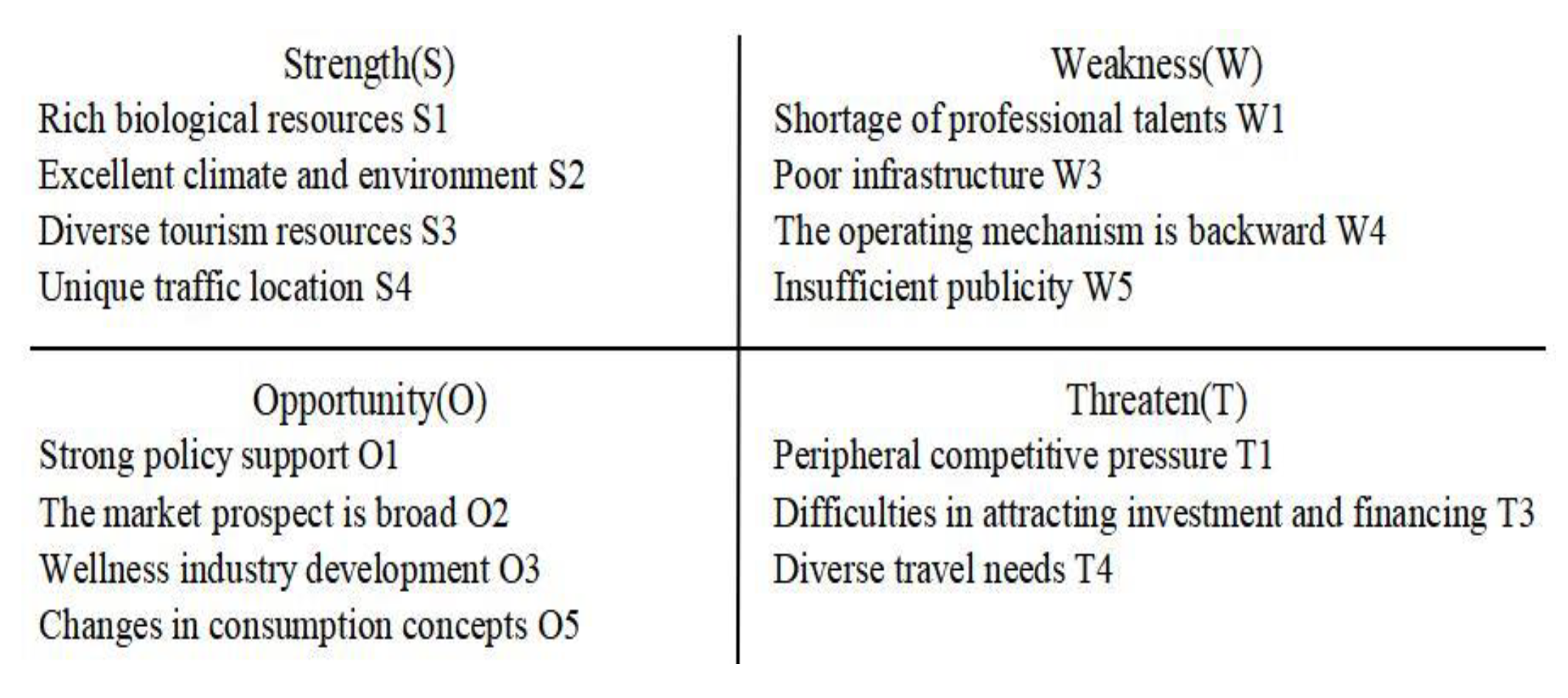
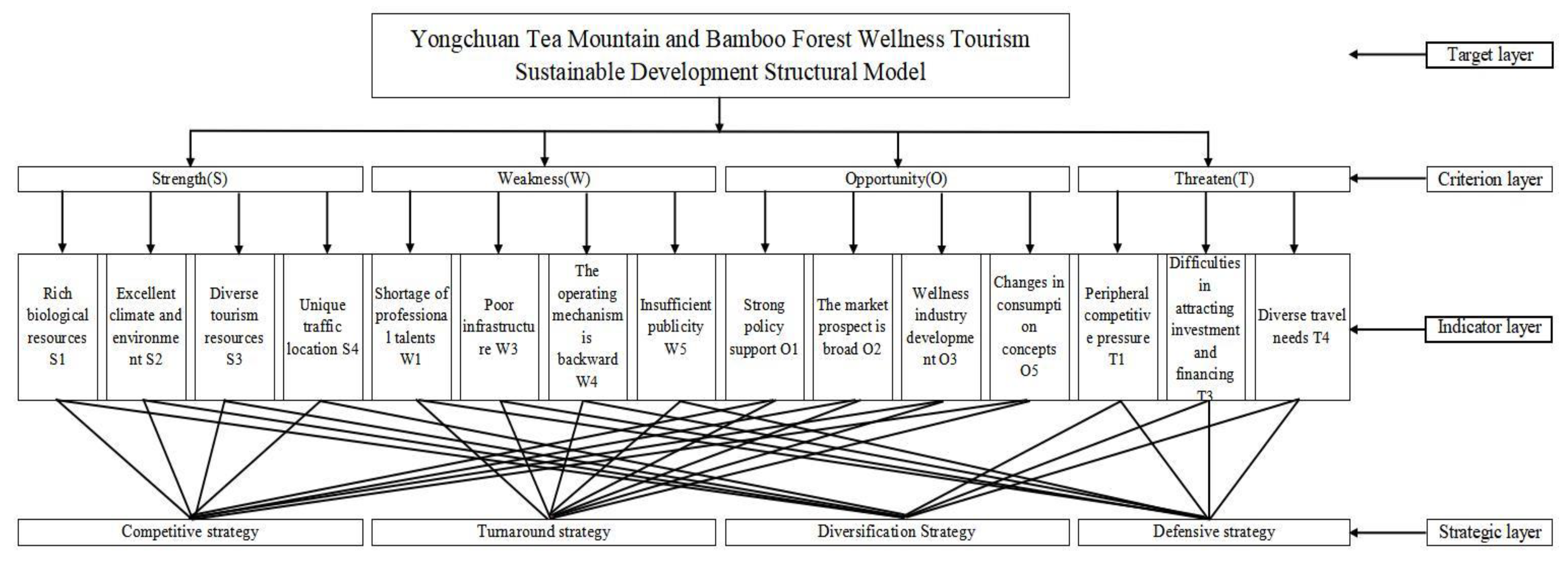
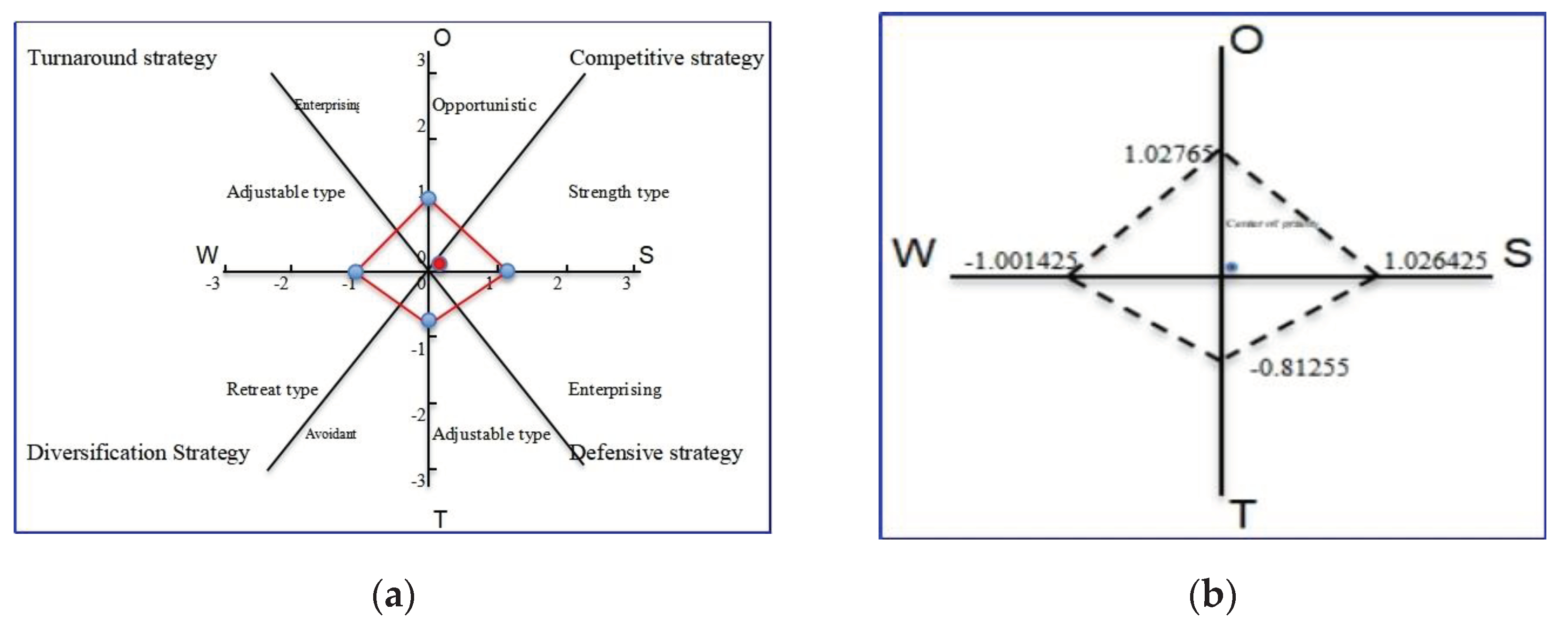
| Target layer | Criterion layer | Indicator layer |
| Sustainable development of Chongqing Tea Mountain and Bamboo Forest National Park | Strength(S) | S1. Rich biological resources |
| S2. Excellent climate and environment S3. Diverse tourism resources S4. Unique traffic location S5. Colorful national culture S6. Good policy environment S7. Diverse local characteristics S8. Stable customer market | ||
| Weakness(W) | W1. Shortage of professional talents W2. Limited development level W3. Poor infrastructure W4. Backward operating mechanism W5. Insufficient publicity W6. Insufficient industrial integration W7. Low concept awareness W8. Lack of technical support |
|
| Opportunity(O) | O1. Strong policy support | |
| O2. Broad market prospect O3. Wellness industry development O4. Industry transformation and upgrading O5. Consumption concepts Changes | ||
| Threaten(T) | T1. Peripheral competitive pressure T2. Technology introduction Difficult T3. Investment and financing Difficult T4. Diverse travel needs T5. Ecological protection |
| Target Layer | Criterion Layer | Weight within Group | Indicator Layer | Weight within Group | Combination Weight | Factor Score | Weight Score | |
|---|---|---|---|---|---|---|---|---|
| Sustainable development Structural Model of Chongqing Tea Mountain and Bamboo Forest National Park |
Strength | 0.4605 | S1 | 0.4903 | 0.1226 | 4 | 0.4903 | |
| S2 | 0.2381 | 0.0595 | 5 | 0.2976 | ||||
| S3 S4 |
0.1392 0.1324 |
0.0348 0.0331 |
4 3 |
0.1392 0.0993 |
||||
| Weakness | 0.1366 | W1 W3 W4 W5 |
0.6341 0.1858 0.0924 0.0877 |
0.1585 0.0465 0.0321 0.0219 |
-4 -5 -3 -3 |
-0.6341 -0.2323 -0.0693 -0.0658 |
||
| Opportunity | 0.3285 | O1 O2 O3 O5 |
0.5046 0.2386 0.1280 0.1288 |
0.1262 0.0597 0.0320 0.0322 |
4 5 3 4 |
0.5046 0.2983 0.0960 0.11288 |
||
| Threaten | 0.0744 | T1 | 0.4689 | 0.1172 | -3 | -0.3517 | ||
| T3 T4 |
0.2502 0.2809 |
0.0626 0.0702 |
-4 -3 |
-0.2502 -0.2107 |
| Characteristic | Factors | WeightCoefficient | Aggressive portfolio strategy | |||||
|---|---|---|---|---|---|---|---|---|
| SO1 | SO2 | SO3 | ||||||
| ES | TES | ES | TES | ES | TES | |||
| Strength | S1 S2 S3 S4 |
0.06878 0.06633 0.06388 0.07123 |
4 4 4 3 |
0.27512 0.26532 0.25552 0.21369 |
4 3 2 2 |
0.27512 0.19899 0.12776 0.14246 |
2 3 4 4 |
0.13756 0.19899 0.25552 0.28492 |
| Weakness | W1 W3 W4 W5 |
0.06633 0.06265 0.07 0.06143 |
1 2 2 2 |
0.06633 0.1253 0.13616 0.12286 |
3 2 3 3 |
0.19899 0.1253 0.20424 0.18429 |
1 3 2 2 |
0.06633 0.18795 0.13616 0.12286 |
| Opportunity | O1 O2 O3 O5 |
0.07 0.06388 0.06283 0.06843 |
4 3 3 3 |
0.26672 0.19164 0.18849 0.20529 |
3 4 4 3 |
0.20004 0.25552 0.25132 0.20529 |
3 2 2 4 |
0.20004 0.12776 0.12566 0.27372 |
| Threaten | T1 T3 T4 |
0.07 0.07 0.07 |
3 2 2 |
0.21735 0.14 0.13406 |
3 2 2 |
0.21735 0.14 0.13406 |
3 3 4 |
0.21735 0.21 0.26812 |
| Total | 2.80385 | 2.86073 | 2.81294 | |||||
Disclaimer/Publisher’s Note: The statements, opinions and data contained in all publications are solely those of the individual author(s) and contributor(s) and not of MDPI and/or the editor(s). MDPI and/or the editor(s) disclaim responsibility for any injury to people or property resulting from any ideas, methods, instructions or products referred to in the content. |
© 2024 by the authors. Licensee MDPI, Basel, Switzerland. This article is an open access article distributed under the terms and conditions of the Creative Commons Attribution (CC BY) license (http://creativecommons.org/licenses/by/4.0/).





